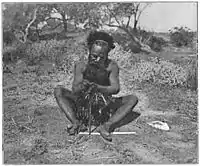Arabana language
Arabana or Arabuna /ˈʌrəbʌnə/[4] is an Australian Aboriginal language of the Pama–Nyungan family, spoken by the Wongkanguru and Arabana people.
| Arabana | |
|---|---|
| Arabana-Wangkangurru | |
 An Arabana man making fire, c. 1904 | |
| Region | South Australia; west side Lake Eyre to Stuart Range, Maree, Port Augusta |
| Ethnicity | Arabana people, Wongkanguru |
Native speakers | 31 (2021 census)[1] |
Pama–Nyungan
| |
| Dialects |
|
| Language codes | |
| ISO 639-3 | Either:ard – Arabanawgg – Wangganguru |
| Glottolog | arab1266 |
| AIATSIS[3] | L13 Arabana (cover term), L27 Wangkangurru |
| ELP | Arabana-Wangkangurru |
 Arabana is classified as Critically Endangered by the UNESCO Atlas of the World's Languages in Danger | |
The language is in steep decline, with an estimated 250 speakers according to 2004 NILS, to just 21 speakers found in the 2006 census.[3]
Geographic distribution
Arabana is spoken at Neales River on the west side of Lake Eyre west to the Stuart Range; Macumba Creek south to Coward Springs; at Oodnadatta, Lora Creek, Lake Cadibarrawirracanna, and The Peake. Their boundary with the Kokatha People to their west is marked by the margin of the scarp of the western tableland near Coober Pedy.[3]
Dialects
Arabana has three dialects: Piltapalta, which Hercus refers to as "Arabana Proper", Wangkakupa, and Midhaliri.[3] Wangganguru was also considered a dialect.
Phonology
Most of the nasals and laterals are allophonically prestopped.[5]
| Peripheral | Laminal | Apical | ||||
|---|---|---|---|---|---|---|
| Bilabial | Velar | Palatal | Dental | Alveolar | Retroflex | |
| Stop | p | k | c | t̪ | t | ɖ |
| Nasal | m ~ ᵇm | ŋ | ɲ ~ ᶡɲ | n̪ ~ ᵈ̪n̪ | n ~ ᵈn | ɳ |
| Lateral | ʎ ~ ᶡʎ | l̪ ~ ᵈ̪l̪ | l ~ ᵈl | ɭ | ||
| Vibrant | ɾ ~ r | |||||
| Approximant | w | j | ɻ | |||
Arabana has three phonemic vowel sounds as is typical in other Australian languages.
| Front | Back | |
|---|---|---|
| High | i | u |
| Low | a | |
Bibliography
- Hercus, Luise. 1994. A grammar of the Arabana-Wangkangurru language Lake Eyre Basin, South Australia: Pacific Linguistics C128. Canberra: Pacific Linguistics.
References
- Australian Bureau of Statistics (2021). "Cultural diversity: Census". Retrieved 13 October 2022.
- RMW Dixon (2002), Australian Languages: Their Nature and Development, p xxxvii
- L13 Arabana (cover term) at the Australian Indigenous Languages Database, Australian Institute of Aboriginal and Torres Strait Islander Studies (see the info box for additional links)
- Laurie Bauer, 2007, The Linguistics Student’s Handbook, Edinburgh
- Jeff Mielke, 2008. The emergence of distinctive features, p 135
External links
- Arabana Aboriginal Corporation, representing traditional owners of Arabana country
- Bibliographies of published, rare or special materials on Arabana language and people, at the Australian Institute of Aboriginal and Torres Strait Islander Studies